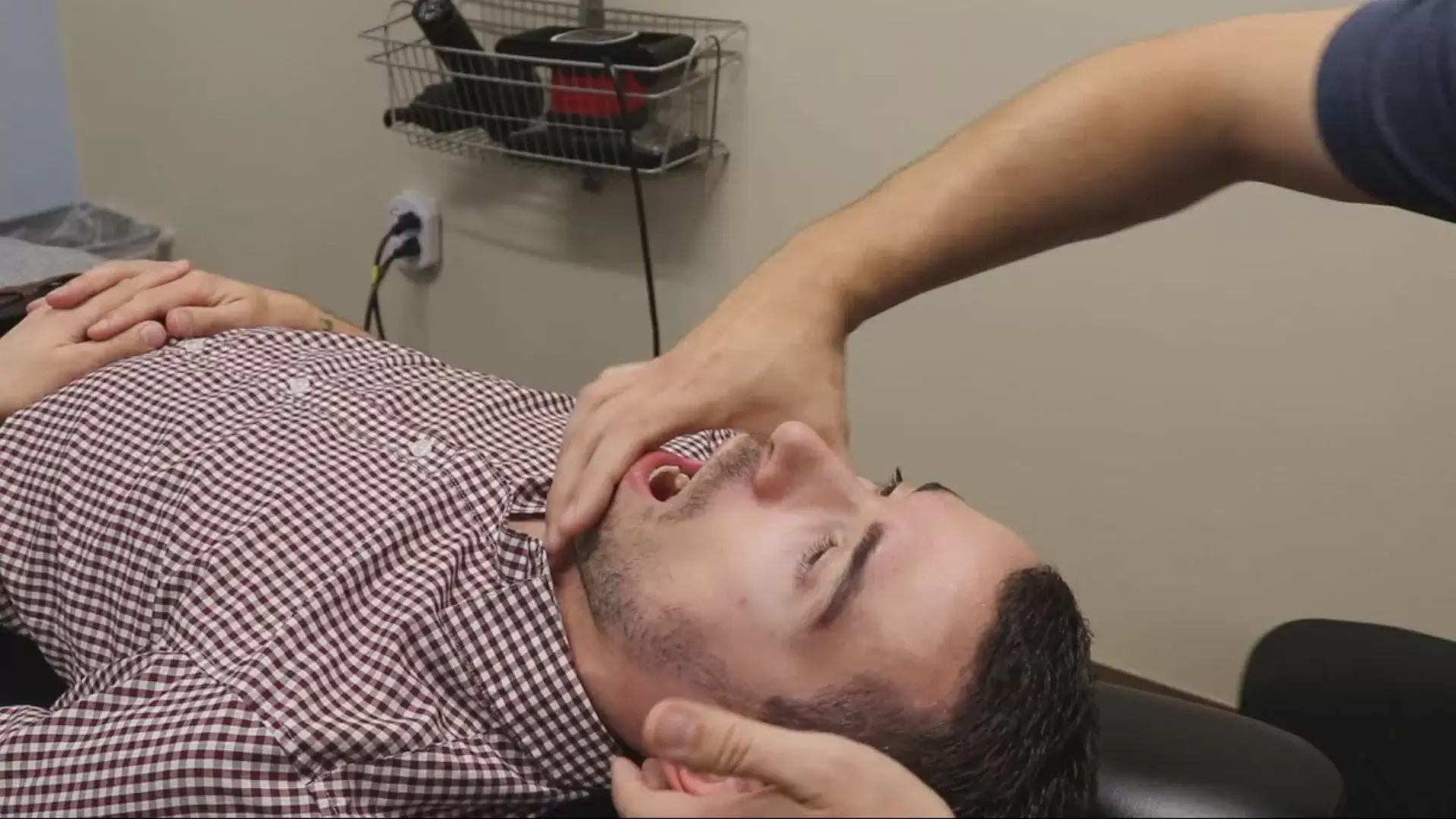If you’re seeking a chiropractor for TMJ issues in Mississauga, we’re here to help. Our Expert Practitioners in Mississauga’s approach combines chiropractic care and specialized therapies tailored to alleviate jaw pain and enhance function. We focus on addressing the root causes of your discomfort, using techniques like joint mobilization and myofascial release. Together, we’ll create a personalized treatment plan that may also incorporate lifestyle adjustments for long-term relief. We’re committed to supporting your journey towards improved well-being, and there are more insights to explore that can further aid your understanding and recovery.

At Mississauga Physio Chiro Clinic, we offer extensive physiotherapy and chiropractic services designed to effectively address TMJ issues and enhance overall well-being. Our team specializes in treating TMJ disorders and temporomandibular joint dysfunction through a combination of physical therapy and chiropractic care. We recognize the complexities of TMJ treatment and utilize a variety of effective techniques, including manual therapy, myofascial release, and trigger point therapy.
These methods are tailored to target the underlying causes of discomfort and pain associated with TMJ disorders. Our approach focuses on pain management, helping to alleviate symptoms while restoring function to the jaw. We believe that thorough care is essential for lasting results, which is why we incorporate personalized treatment plans to meet each patient’s unique needs.
TMJ disorders can greatly impact jaw function and overall health, leading to discomfort that affects daily activities and quality of life. When the temporomandibular joint is compromised, we may experience jaw pain, stiffness, and dysfunction. These symptoms can make simple tasks, like eating or speaking, quite challenging.
Many of us may also suffer from bruxism, or teeth grinding, which contributes to TMJ inflammation and exacerbates jaw pain. This unconscious habit often occurs during sleep, leading to facial pain and increased tension in the jaw muscles. Over time, these issues can create a cycle of discomfort, where jaw stiffness leads to headaches and further limits our daily activities.
It’s important to recognize that TMJ disorders can extend beyond just the jaw. The pain and tension can radiate throughout the face, neck, and shoulders, impacting our overall well-being. By addressing these issues early on, we can work towards restoring proper jaw function and improving our quality of life. Seeking professional help, like chiropractic care, can provide us with the necessary tools and techniques to manage TMJ disorders effectively.
Several key factors can contribute to the development of TMJ dysfunction, affecting our jaw health and overall well-being. One significant cause is jaw misalignment or bite misalignment, which can lead to improper functioning of the temporomandibular joint (TMJ). This misalignment creates joint instability, resulting in symptoms like jaw clicking and orofacial pain.
Additionally, muscle tension plays an essential role in exacerbating TMJ dysfunction. Stress management becomes critical, as heightened stress levels often lead to increased muscle tension around the jaw, aggravating the condition. In some cases, conditions like TMJ arthritis or degenerative joint disease can also contribute to the deterioration of the joint, intensifying discomfort and pain.
Understanding these risk factors allows us to take proactive steps in managing our jaw health. By identifying the underlying causes, we can work toward effective treatment options, including chiropractic care, that address these issues holistically. Ultimately, recognizing these key causes helps us better navigate our journey toward improved well-being and relief from TMJ dysfunction.
Recognizing the signs and symptoms of TMJ disorders is vital for identifying issues early and seeking appropriate care. We often notice symptoms like jaw popping or locking, which can indicate underlying problems with the temporomandibular joint syndrome. Clenching our jaws, especially during stress, can lead to increased tension and discomfort.
Many of us may experience ear pain or neck pain that seems unrelated, but these can be linked to TMJ disorders. Additionally, jaw swelling and facial asymmetry might become noticeable, prompting us to seek evaluation. Headache disorders, particularly tension headaches, can also stem from TMJ dysfunction, further complicating our daily lives.
Chewing difficulty is another common symptom; we may find ourselves avoiding certain foods due to discomfort. It’s important to be aware of these signs and symptoms, as they can greatly influence our quality of life. If we recognize any of these issues, it’s a good idea to consult with a healthcare professional who specializes in TMJ disorders to explore potential treatment options. Addressing these symptoms early can lead to better outcomes and improved overall health.

Chiropractic care offers a holistic approach to alleviate TMJ pain and dysfunction, focusing on restoring balance and proper alignment in the jaw and surrounding structures. By addressing issues related to craniofacial pain, we can help reduce discomfort without the need for invasive solutions like TMJ surgery.
Our methods often include joint mobilization and postural correction, which can greatly enhance function and reduce pain. We also recognize the importance of incorporating neuromuscular dentistry practices, which help to align the bite and jaw properly. This integration can lead to long-term relief and improved overall health.
Additionally, TMJ rehabilitation plays an essential role in our treatment plans. We may recommend oral appliance therapy to stabilize the jaw position and prevent further strain. Furthermore, anti-inflammatory treatment strategies can support the healing process, promoting a quicker recovery.
At our clinic located at 1834 Lakeshore Rd W #6C, Mississauga, ON L5J 1J7, we’re committed to providing personalized care tailored to each patient’s needs. Through a thorough approach, we aim to empower our patients to regain control over their health and well-being, ultimately improving their quality of life.
Aligning the spine and jaw is essential for effectively addressing TMJ issues, as proper alignment can alleviate strain on the jaw muscles and improve overall function. Many of us may not realize that malocclusion, or misalignment of the teeth, can lead to excessive tension in the masticatory muscles. By utilizing techniques from orthodontics, we can help correct these misalignments, which may involve the use of a TMJ splint or occlusal splint to provide support.
In our practice, we often recommend combining chiropractic adjustments with additional therapies, such as heat therapy, to relax tight muscles and enhance mobility. For a thorough evaluation, TMJ imaging, including an MRI for TMJ, can help us identify underlying issues that contribute to discomfort. Additionally, muscle relaxants may be prescribed to further alleviate tension.
Manual therapy and myofascial release techniques can considerably reduce TMJ pain by targeting the connective tissues and muscles surrounding the jaw. We often find that conditions like TMD, which can involve issues such as joint degeneration and TMJ disc displacement, respond well to these approaches. By focusing on the masseter muscle and its connection to the trigeminal nerve, we can alleviate tension and discomfort effectively.
Incorporating ultrasound therapy and TENS therapy into our treatment plans enhances the benefits of myofascial release. These modalities help in reducing inflammation and improving circulation within the affected area. Additionally, we may recommend ice therapy to manage acute pain and swelling, providing immediate relief to our patients.
For some cases, using a dental splint can further support our manual therapy efforts by stabilizing the jaw and preventing further strain. As we work together, it’s important to communicate openly about the progress we’re making. By combining these techniques, we can create a thorough treatment strategy tailored to each individual’s needs, ultimately promoting a healthier, pain-free jaw.
One effective way to alleviate TMJ strain and discomfort is by improving our overall posture, as poor alignment can greatly contribute to jaw tension and pain. When we sit or stand incorrectly, it can lead to issues like TMJ subluxation or even TMJ dislocation. By making a conscious effort to maintain good posture, we can minimize these risks.
Using a bite guard or night guard can also complement our posture improvement, protecting our teeth and jaw from further strain during sleep. Additionally, we should be aware that poor posture can exacerbate conditions like disc displacement without reduction or disc displacement with reduction. If left unaddressed, these issues may lead to more severe complications, including condylar resorption and facial nerve pain.
In some cases, we might even experience speech problems as a result of misalignment. Incorporating practices from prosthodontics can provide supportive strategies for maintaining ideal posture and managing TMJ symptoms. By working together to cultivate better postural habits, we can greatly reduce TMJ discomfort and enhance our overall well-being.
While improving our posture lays a strong foundation for TMJ relief, managing stress and incorporating relaxation techniques can further alleviate the symptoms associated with this condition. Chronic stress often exacerbates TMJ issues, leading to increased muscle tension and discomfort. By practicing stress reduction techniques, we can help mitigate these effects.
Integrating mindfulness, deep breathing exercises, or yoga into our daily routine can considerably enhance our overall wellbeing and reduce TMJ symptoms. Additionally, exploring options like botox for TMJ can provide relief from muscle tension and pain, while corticosteroid injections may help reduce inflammation when necessary. For those experiencing tinnitus as a symptom of TMJ, relaxation techniques can also serve to minimize the perceived noise and discomfort.
Over-the-counter NSAIDs can be beneficial for managing pain, but we should always consult with our healthcare provider before starting any new treatment. Ultimately, combining relaxation practices with professional guidance guarantees a holistic approach to managing TMJ symptoms. By prioritizing stress reduction, we not only support our physical health but also improve our quality of life, making every day more enjoyable.

Hot and cold therapy can be effective tools in our arsenal for managing TMJ inflammation and pain relief. Applying heat helps increase blood flow to the affected area, promoting relaxation of the muscles around the jaw. This can alleviate tension and stiffness, making it easier for us to open and close our jaws without discomfort. We can use a warm compress, heating pad, or even a warm towel for about 15-20 minutes to reap these benefits.
On the other hand, cold therapy is beneficial for reducing inflammation and numbing sharp pain. Ice packs or cold compresses can be applied for 10-15 minutes to help minimize swelling and provide a soothing effect. This contrast between hot and cold not only addresses immediate symptoms but also aids in our overall recovery process.
It’s essential to listen to our bodies when using these therapies. If we experience increased pain or discomfort, we should adjust the temperature or duration of application. By incorporating hot and cold therapy into our routine, we can effectively manage TMJ-related pain and enhance our overall comfort as we navigate through recovery.
Chiropractic care and physiotherapy can complement each other effectively in our journey toward TMJ recovery, addressing both the structural and functional aspects of the condition. By combining these two approaches, we can achieve a more thorough treatment plan that targets the root causes of our TMJ issues.
Chiropractors focus on the alignment of the spine and jaw, guaranteeing that any misalignments are corrected. This realignment helps to relieve pressure on the temporomandibular joint, reducing pain and discomfort. On the other hand, physiotherapists specialize in restoring movement and function through targeted exercises and manual therapy. They help us strengthen the muscles surrounding the jaw, improve flexibility, and enhance overall mobility.
When we integrate chiropractic adjustments with physiotherapy exercises, we create a synergistic effect that promotes healing and recovery. Regular communication between our healthcare providers guarantees that our treatment is tailored to our specific needs, making adjustments as necessary. Together, these modalities empower us to regain control over our TMJ health, ultimately leading to improved quality of life and reduced symptoms. By working collaboratively, we can optimize our healing process and achieve lasting relief.
TENS (Transcutaneous Electrical Nerve Stimulation) and ultrasound therapy are innovative treatment options that can greatly alleviate the pain associated with TMJ disorders. These therapies provide non-invasive methods to manage discomfort, making them a valuable part of our all-encompassing TMJ treatment approach.
When we use TENS, small electrical impulses are delivered through electrodes placed on the skin near the affected area. This process helps to block pain signals from reaching the brain and can also stimulate the release of endorphins, our body’s natural painkillers. Many of us find immediate relief during and after treatment sessions.
On the other hand, ultrasound therapy utilizes sound waves to penetrate deep tissue, promoting increased blood flow and reducing inflammation in the jaw area. This therapy not only aids in pain relief but also accelerates the healing process by enhancing tissue repair.
Both TENS and ultrasound therapy can be seamlessly integrated into our overall treatment plan, providing significant benefits to those suffering from TMJ disorders. By incorporating these advanced pain relief techniques, we can work together towards achieving ideal comfort and functionality in our daily lives.
Oral appliances play an essential role in the treatment of TMJ disorders by helping to correct bite alignment and reduce strain on the jaw. These custom-made devices, often referred to as occlusal splints or night guards, are designed to fit comfortably over our teeth. By doing so, they can help distribute forces evenly while we chew, which alleviates pressure on the temporomandibular joint.
When we wear these appliances, they can also prevent teeth grinding and clenching, both common issues associated with TMJ disorders. This not only protects our teeth from damage but also helps relax the muscles surrounding the jaw, leading to decreased pain and discomfort.
In addition to providing immediate relief, oral appliances can facilitate long-term changes in our bite alignment. By promoting proper jaw positioning, they can help retrain our muscles and joints to function more effectively over time.
When it comes to managing TMJ disorders, we often find ourselves weighing the benefits of non-surgical treatments against surgical options to determine the best path for relief and recovery. Non-surgical treatments typically include methods such as physical therapy, chiropractic care, oral appliances, and medication. These approaches aim to alleviate pain and restore function without the risks associated with surgery. They offer a less invasive way to manage symptoms and can often be effective in improving overall jaw function.
On the other hand, surgical options, while sometimes necessary, come with their own set of risks and recovery times. Surgical interventions may be recommended for severe cases where non-surgical treatments have failed to provide adequate relief. However, surgery should generally be considered a last resort due to the potential for complications and the necessity of rehabilitation.
Ultimately, the decision between non-surgical and surgical treatments should involve careful consideration of our specific symptoms, medical history, and lifestyle. Consulting with healthcare professionals, including chiropractors and oral specialists, can provide us with personalized guidance to choose the most suitable approach for our TMJ disorder.
Incorporating long-term care strategies and lifestyle changes can greatly help us prevent TMJ symptoms and enhance our overall jaw health. To start, we should focus on stress management techniques, such as mindfulness and relaxation exercises. Stress often leads to jaw clenching, which exacerbates TMJ issues, so finding effective ways to unwind is essential.
Next, let’s pay attention to our posture. Maintaining proper alignment can reduce strain on our jaw muscles. Regularly checking our posture, especially while sitting or using electronic devices, can make a significant difference in our jaw health.
Additionally, we might want to rethink our diet. Consuming softer foods can lessen the pressure on our jaw joints, while avoiding hard or chewy foods can prevent unnecessary strain. Staying hydrated is also important, as it helps keep our muscles functioning properly.
Lastly, regular physical activity can improve our overall well-being and help us manage stress. By integrating these strategies into our daily routine, we can create a supportive environment for our jaw health, ultimately reducing the likelihood of TMJ symptoms and enhancing our quality of life.
Booking a consultation for expert chiropractic TMJ treatment in Mississauga can be a pivotal step towards alleviating discomfort and restoring jaw function. When we visit a chiropractor, we’ll benefit from a thorough assessment that identifies the root causes of our TMJ issues. This approach allows us to understand how our specific symptoms are interlinked with our overall health.
During the consultation, we’ll discuss our medical history, lifestyle habits, and any pain or discomfort we’ve been experiencing. This detailed evaluation helps our chiropractor develop a personalized treatment plan tailored to our needs. Treatment options may include spinal adjustments, soft tissue therapies, and exercises designed to improve jaw mobility and reduce tension.
We’ll also receive valuable guidance on self-care strategies and lifestyle changes that can further support our recovery. By being proactive and seeking expert help, we’re taking an important step toward better health and well-being.
If we’re struggling with TMJ symptoms, let’s not hesitate to contact us. Booking that consultation could be the key to a pain-free, functional jaw and an improved quality of life.
Mississauga, a vibrant city in Ontario, offers a rich blend of cultural diversity, thriving businesses, and beautiful parks that enhance our quality of life. As one of the largest cities in Canada, we enjoy a dynamic community with over 700,000 residents, representing numerous cultures and backgrounds. This diversity not only enriches our social fabric but also fosters a welcoming environment for all.
Our city features a robust economy, anchored by various industries such as technology, healthcare, and manufacturing. We’re proud to support local businesses while also attracting international corporations, making Mississauga a hub for innovation and opportunity.
Nature lovers among us can appreciate the abundance of green spaces. With over 500 parks and numerous trails, we can easily find spots for leisure and recreation. Moreover, our proximity to Lake Ontario offers additional scenic views and outdoor activities.
In terms of health and wellness, Mississauga prioritizes access to healthcare services, including specialized treatments like chiropractic care for TMJ disorders. As we continue to thrive, we remain committed to fostering a healthy community that supports the well-being of all residents.

A typical chiropractic session for TMJ usually lasts around 30 to 60 minutes. We’ve found that this duration allows for a thorough assessment and effective treatment. During the session, we’ll discuss our symptoms, perform adjustments, and provide exercises for relief. It’s important to remember that each individual’s needs may vary, so we may adjust the length based on our specific condition and progress. Regular sessions can profoundly enhance our overall well-being.
When it comes to insurance coverage for chiropractic treatment of TMJ disorders, it varies by policy. We should check our specific plan details or contact our insurance provider directly. Many plans do cover chiropractic care, but there may be limitations or requirements. We can also ask our chiropractor for assistance in understanding how our treatment might fit within our insurance’s parameters. It’s always best to be informed about our coverage options.
When considering chiropractic care for TMJ pain, we should be aware of potential side effects. Some individuals might experience temporary discomfort, increased soreness, or mild headaches following treatment. However, these effects are usually short-lived and can often be managed with rest and hydration. It’s important to communicate openly with our chiropractor about any concerns and to make certain we’re receiving tailored care that addresses our specific needs for best results.
Yes, children can benefit from chiropractic treatment for TMJ issues. We’ve seen that chiropractic care can help alleviate discomfort and improve jaw function in kids. By addressing misalignments and tension, it promotes better overall health. It’s crucial, however, to consult with a qualified chiropractor who specializes in pediatric care to guarantee the treatment is safe and appropriate for our child’s specific needs. We’re all about supporting healthy development and well-being for our younger ones.
When addressing TMJ relief, we often find that the number of sessions required can vary considerably based on individual circumstances. Typically, patients might need anywhere from 4 to 12 sessions to experience noticeable improvement. It’s important for us to assess each case thoroughly and adjust our approach accordingly. Ultimately, we’re dedicated to working closely with you to determine the best treatment plan tailored to your specific needs and progress.
Reach out to us today to book an appointment or learn more about our services. Our friendly team is here to answer your questions and help you take the first step toward improved health and wellness.
(647) 372-1209

At our Mississauga Physio Chiro Clinic, we are dedicated to providing personalized care that addresses the root cause of your discomfort. With a team of experienced physiotherapists and chiropractors, we focus on restoring your mobility, relieving pain, and enhancing your overall well-being.